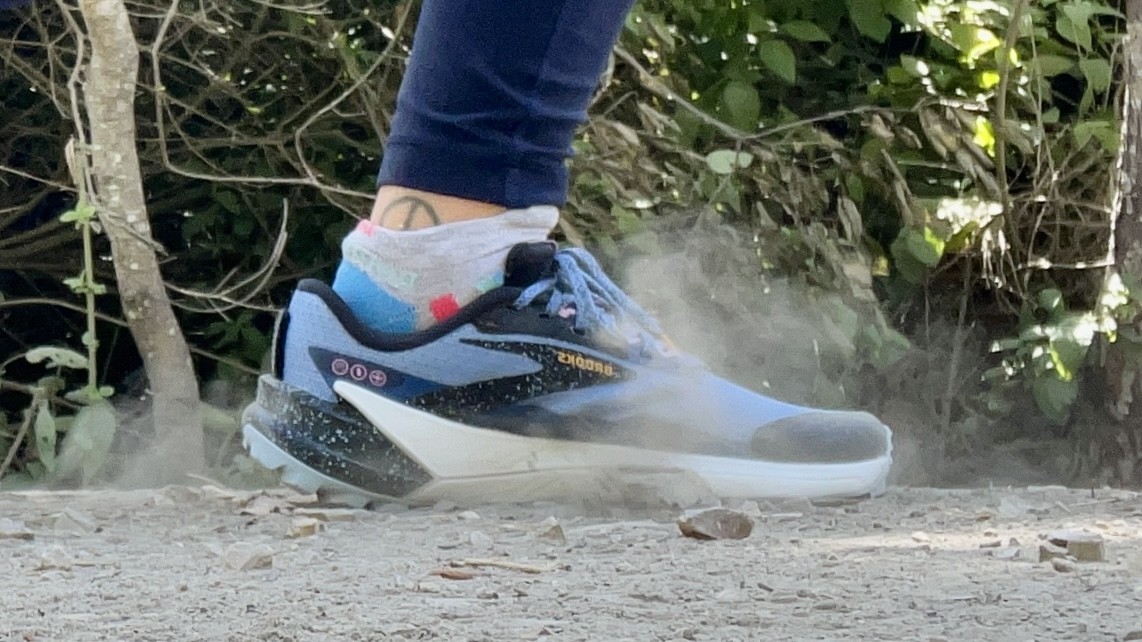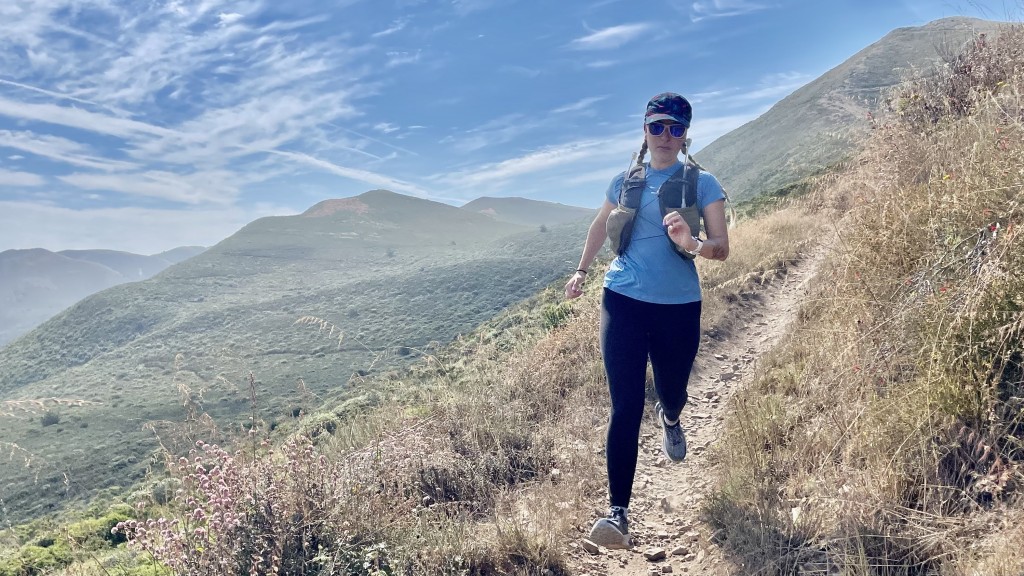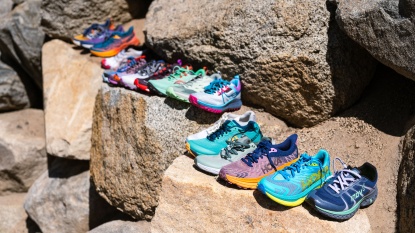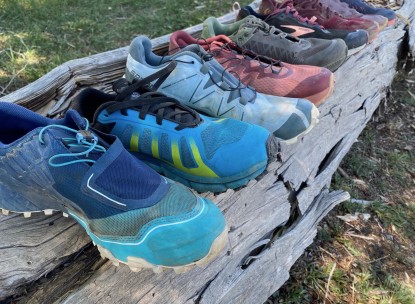Brooks Catamount 2 - Women's Review
Our Verdict
Our Analysis and Test Results
Updates to the Brooks Catamount have made it a shoe worthy of ripping up alpine trails laced with switchbacks. The SkyVault rock plate acts as a propulsive device, protecting your soles while also allowing you to hit the gas as you climb.
Foot Protection
In an incredibly unique twist, Brooks released the second edition of the Catamount with a dual-purpose rock plate that effectively serves both intended purposes. The propulsive plate embedded within the shoe doubles as a rock plate, protecting the soles of your feet from jagged objects you may encounter in the backcountry. With a bit more midfoot flexibility than its predecessor, the Catamount 2 isn't the most protective trail shoe on the market, but it enthusiastically gets the job done.
The toe bumper is thick and protective without being rigid, and the traditional heel contour keeps sand out. As expected, the tightly woven upper is not waterproof but does a passable job of deflecting water splashes. The lightness of the upper is impressively breathable, allowing the toe box to run a bit cooler than the majority of the shoes in our lineup. This breathability also allows the Catamount to drain quickly if your adventure takes you through a small stream or two.
Traction
The Catamount 2 is fully equipped to tackle rocky terrain, though its lugs aren't quite as long as some of the more mud-ready kicks in our lineup. The TrailTack outsole is grippy, and the multipoint lugs keep you steady and stable around high-speed corners. The outsole of the Catamount is slightly wider than the shoe, adding to its stability and traction during directional changes. Our testers often opted for the Catamount when sandy switchbacks were on the agenda. The responsiveness, stability, and grippy traction come together beautifully on this type of terrain. Though not our go-to recommendation for ultra-mucky trail outings, the Catamount holds its own on granite, scree, and loose rocks. If your runs lean more toward rolling cross-country fun than muddy, wet, punishing slogs, you'll enjoy the traction that the Catamount provides.
Sensitivity
On soft trails, the plate embedded into the sole of the Catamount is imperceptible at best. This is one of the rare shoes that offers both underfoot protection and an adequate amount of sensitivity. The outsole is a bit more flexible than its less sensitive counterparts, adding to the overall trail feel. The moderate drop allows the full outsole to be above average in the sensitivity department, further adding to the balance between underfoot cushion and sensitivity. The updated Catamount will appeal to runners looking for some sensitivity but not as a first priority. Our notable comment here is that the embedded plate is very noticeable if you take the Catamount for a spin on the roads. We fared well on fire roads but do not recommend this trail runner as a crossover shoe because of the plate sensation underfoot. But if you want a shoe that provides underfoot cushion and sensitivity, the balance of the two on the Catamount is pretty top-notch.
Stability
This neutrally supportive trail shoe hits the nail on the head when it comes to stability. The shape of the shoe body is neutral, which can feel like it is lacking support to overpronators. If you like the ride of a neutral shoe and see a lot of quick directional changes in your future, the support of the Catamount 2 might feel just right. The lateral edges of the shoe don't have any built-in supports for structure, but the engineered mesh is sturdy and strong. This allows the upper to conform to your foot shape, creating a nimble ride while encouraging muscular engagement. The Catamount has a 4mm drop (Brooks claims 6mm, but we measured 4mm) and rides like a shoe with a shallow stack height, though it has a 26mm stack at the heel. The shallow ride sensation feels very secure underfoot, encouraging muscular stability.
Comfort and Fit
The Catamount 2 seamlessly marries rigidity and comfort for those who want a little bit of everything. For runners who want padded protection without the bulk of a maximalist trail shoe, this is a great option. It lacks the beef of some truly rugged shoes, which allows it to be a more comfortable fit, especially if you are new to the rigidity of trail running shoes. The heel collar and tongue are well-cushioned, but the interior is denser, preventing the shoe from feeling mushy underfoot. The tongue is attached to the insole via stretchy bootie liners, which help the tongue stay in place as you run. The caveat in this metric is that the Catamount runs a bit narrow, so if a wide toe box is more your style, this won't be the shoe for you.
The fit is moderately narrow through the midfoot but more dramatically so in the toe box. However, after a few runs, the engineered mesh upper conforms to your foot shape, which makes the shoe feel more spacious. Brooks is not currently making a wide version of this shoe, so if your feet run on the wider side, we have recommendations that might suit you better. Ultimately, the Catamount scored well in this metric because of its cushion-where-you-need-it-but-not-where-you-don't attitude, so if it fits your foot, we think you'll love its comfort.
Weight
The Catamount 2 weighs in at 7.59 ounces per women's size 6.5 shoe, which is pretty dang good. It offers a significant bang for your buck in terms of its weight-to-protection ratio, so if a moderately protective shoe with a multi-purpose rock plate is what you're after, this might be the shoe for you. The weight is well-distributed, providing a really balanced and bouncy ride. While not a minimalist shoe, the lighter-than-average weight and well-placed padding ensure that the Catamount remains comfortable, even if logging double-digit mileage is what you're into.
Should You Buy the Brooks Catamount 2?
The main reason we think that you might not want to buy the updated Catamount 2 is because of its semi-narrow fit. Our average-footed testers noticed the slight narrowness but were never truly bothered by it, especially after a few break-in miles. If you want shoes with a bigger toe box, don't settle for squished toes, as there are plenty of other awesome options on the market. The only other reasons why we wouldn't recommend the Catamount is that it simply isn't built for muddy, sloppy trails, and it runs on the pricier side. But if you want a peppy, stable shoe that offers some sensitivity, a slightly lower drop height, and a dual-purpose plate, you cannot go wrong with the redesigned Catamount by Brooks.
What Other Trail Running Shoes Should You Consider?
The Hoka Torrent 3 is another great shoe to check out, as it offers a similar trail feel. The Saucony Peregrine 13 is a more traditionally fitted shoe with slightly more rugged traction. If you want a lightweight shoe with a rock plate, but the Catamount doesn't feel quite right, put the Peregrine on your radar (it is also offered in a wide version). If sloppy terrain is calling your name, we never hesitate to recommend the Salomon Speedcross 6 for the muddiest, slipperiest terrain you find. And finally, if you like the fit of a Brooks-made shoe but can't get behind the price of the Catamount, check out the more palatably-priced Brooks Divide 4.












